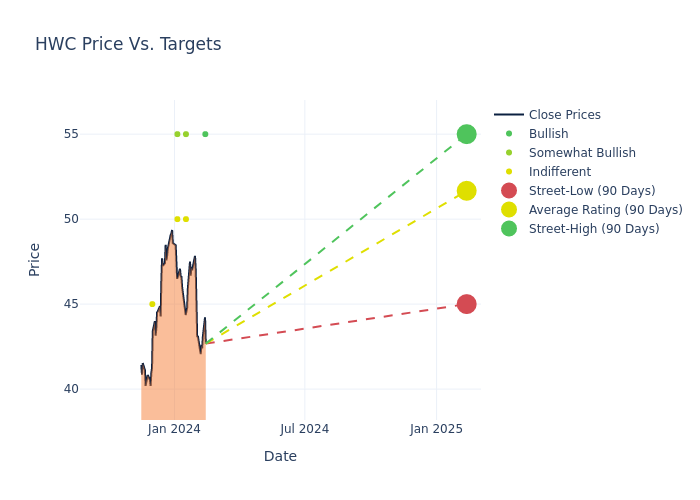8 analysts have shared their evaluations of Hancock Whitney HWC during the recent three months, expressing a mix of bullish and bearish perspectives.
The table below summarizes their recent ratings, showcasing the evolving sentiments within the past 30 days and comparing them to the preceding months.
| Bullish | Somewhat Bullish | Indifferent | Somewhat Bearish | Bearish | |
|---|---|---|---|---|---|
| Total Ratings | 3 | 2 | 3 | 0 | 0 |
| Last 30D | 1 | 0 | 0 | 0 | 0 |
| 1M Ago | 1 | 1 | 1 | 0 | 0 |
| 2M Ago | 1 | 1 | 1 | 0 | 0 |
| 3M Ago | 0 | 0 | 1 | 0 | 0 |
In the assessment of 12-month price targets, analysts unveil insights for Hancock Whitney, presenting an average target of $52.38, a high estimate of $55.00, and a low estimate of $45.00. Marking an increase of 9.13%, the current average surpasses the previous average price target of $48.00.

Investigating Analyst Ratings: An Elaborate Study
The analysis of recent analyst actions sheds light on the perception of Hancock Whitney by financial experts. The following summary presents key analysts, their recent evaluations, and adjustments to ratings and price targets.
| Analyst | Analyst Firm | Action Taken | Rating | Current Price Target | Prior Price Target |
|---|---|---|---|---|---|
| Gary Tenner | DA Davidson | Maintains | Buy | $55.00 | - |
| Gary Tenner | DA Davidson | Announces | Buy | $55.00 | - |
| Brad Milsaps | Piper Sandler | Raises | Overweight | $55.00 | $51.00 |
| Matt Olney | Stephens & Co. | Lowers | Equal-Weight | $50.00 | $55.00 |
| Michael Rose | Raymond James | Raises | Outperform | $55.00 | $45.00 |
| Jennifer Demba | Truist Securities | Announces | Hold | $50.00 | - |
| Jennifer Demba | Truist Securities | Raises | Buy | $54.00 | $41.00 |
| Ben Gerlinger | Citigroup | Announces | Neutral | $45.00 | - |
Key Insights:
- Action Taken: In response to dynamic market conditions and company performance, analysts update their recommendations. Whether they 'Maintain', 'Raise', or 'Lower' their stance, it signifies their reaction to recent developments related to Hancock Whitney. This insight gives a snapshot of analysts' perspectives on the current state of the company.
- Rating: Offering insights into predictions, analysts assign qualitative values, from 'Outperform' to 'Underperform'. These ratings convey expectations for the relative performance of Hancock Whitney compared to the broader market.
- Price Targets: Analysts predict movements in price targets, offering estimates for Hancock Whitney's future value. Examining the current and prior targets offers insights into analysts' evolving expectations.
Considering these analyst evaluations in conjunction with other financial indicators can offer a comprehensive understanding of Hancock Whitney's market position. Stay informed and make well-informed decisions with our Ratings Table.
Stay up to date on Hancock Whitney analyst ratings.
Delving into Hancock Whitney's Background
Hancock Whitney Corp operates bank offices and financial centers. The company offers financial products and services, including traditional and online banking; commercial and small business banking; private banking; trust and investment services; healthcare banking; certain insurance services; and mortgage services. The company also operates a loan production office in Nashville, Tennessee.
Key Indicators: Hancock Whitney's Financial Health
Market Capitalization Analysis: Positioned below industry benchmarks, the company's market capitalization faces constraints in size. This could be influenced by factors such as growth expectations or operational capacity.
Decline in Revenue: Over the 3 months period, Hancock Whitney faced challenges, resulting in a decline of approximately -13.17% in revenue growth as of 31 December, 2023. This signifies a reduction in the company's top-line earnings. As compared to its peers, the revenue growth lags behind its industry peers. The company achieved a growth rate lower than the average among peers in Financials sector.
Net Margin: The company's net margin is below industry benchmarks, signaling potential difficulties in achieving strong profitability. With a net margin of 16.41%, the company may need to address challenges in effective cost control.
Return on Equity (ROE): Hancock Whitney's ROE falls below industry averages, indicating challenges in efficiently using equity capital. With an ROE of 1.39%, the company may face hurdles in generating optimal returns for shareholders.
Return on Assets (ROA): Hancock Whitney's ROA falls below industry averages, indicating challenges in efficiently utilizing assets. With an ROA of 0.14%, the company may face hurdles in generating optimal returns from its assets.
Debt Management: The company maintains a balanced debt approach with a debt-to-equity ratio below industry norms, standing at 0.37.
The Significance of Analyst Ratings Explained
Analysts are specialists within banking and financial systems that typically report for specific stocks or within defined sectors. These people research company financial statements, sit in conference calls and meetings, and speak with relevant insiders to determine what are known as analyst ratings for stocks. Typically, analysts will rate each stock once a quarter.
Some analysts publish their predictions for metrics such as growth estimates, earnings, and revenue to provide additional guidance with their ratings. When using analyst ratings, it is important to keep in mind that stock and sector analysts are also human and are only offering their opinions to investors.
If you want to keep track of which analysts are outperforming others, you can view updated analyst ratings along withanalyst success scores in Benzinga Pro.
This article was generated by Benzinga's automated content engine and reviewed by an editor.
Edge Rankings
Price Trend
© 2025 Benzinga.com. Benzinga does not provide investment advice. All rights reserved.
date | ticker | name | Price Target | Upside/Downside | Recommendation | Firm |
|---|
Trade confidently with insights and alerts from analyst ratings, free reports and breaking news that affects the stocks you care about.